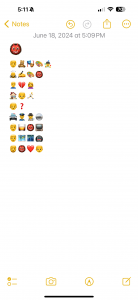
The story I told with emojis is based on a new show on Netflix, which I just finished watching this week. The show is quite complex, therefore it took me some time portraying it with emojis accurately. In hindsight, I should have probably picked a show with stories that would be easier to visualize!
Regardless, while I was trying to recreate the story with emojis, I had to reply on the idea of the show. I realized I focused less on syllables or words, but more on the imagery of the show. I started with the title, as that was actually the hardest part. I wanted to lay out the story with the title first, before I ventured into the body. This process actually made me spend more time on creating the story. I probably should have started with the plot first.
I’ve observed a few phenomenon while recreating the story. Writing (and later reading) the story with emojis felt very different from writing (or reading) text. It reflected strictly what each emoji appeared to be. An emoji of “dad” and a “monster” appeared to mean the dad is perhaps spending time with a monster. However, the story of the show will narrate the story of a dad suffering a mental breakdown from guilt, as he did not take his son to school the day his son went missing. He was not taking medications for his existing psychological disorders, and therefore experiencing visual hallucinations of his son’s drawing of a “monster” puppet. As Gunther Kress (2005) said, visual images can lead to an immediate understanding on paper, but written language can lead to much bigger potential of precision, depictions and deeper comprehension.
On the other hand, the emoji story is much easier and simpler to read isn’t it? As Kress (2005) also indicated, image provided readers different forms of engagement and different modes of reading. It will also allow better communication of things that are best represented by an image. It is more interactive and dynamic, and more suitable for different individual needs when it comes to reading.
This task made me understand more of Kress’ emphasizes that while there are significant gains in the shift to visual and multimodal texts, there are also important losses that need to be acknowledged. There are only more shifts coming as our technology advances. A balanced approach that leverages the strengths of new forms of communication while preserving the critical aspects of traditional literacy would be most beneficial for learners.
References
Kress, G. (2005), Gains and losses: New forms of texts, knowledge, and learning. Computers and Composition, 2(1), 5-22.
Hi Jennie,
I was so eager to try and guess what show you’re depicting with your emoji story, but I’m stumped.
Does it have something to do with demons, drama, heartbreak, the police, and a father loving his son, despite his demons?? Am I on track at all?
Based on your first thought, it sounds like we both faced the challenge of trying to convey a complex show, using a limited set of emojis. Were there any imageries that you felt could not be captured with the emojis currently available? And if so, does this provide any insight into the creators of emojis? In my case, I felt limited by the lack of certain characteristics that are not currently available such as an emoji of a light-skinned character with brown or red hair. This detail would not capture the personality or rich character from the show I was trying to depict, but it would at least help to communicate which character I was trying to showcase.
Similar to you, I also used my iPhone’s Notes application to craft my emoji story and it’s interesting to see that we both split up our string of emojis into separate lines. To me, this made it feel like text is still in control, despite not using any text in the story. Despite no text being used, my emojis were organized as if in sentences and I used spaces between the lines of emojis, as if I was organizing paragraphs to separate ideas. What made you organize your emojis in lines and when were you prompted to start a new line?
Can you elaborate on some of the ‘important losses’ that you think are being lost in the shift to visual and multimodal texts?